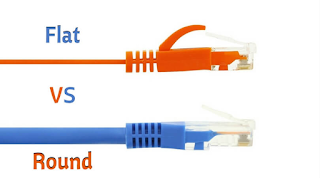Since World War 2, Ethernet cable has undergone a long evolution period from the early Cat3 (Category 3), Cat4, to the nowadays Cat5, Cat5e, Cat6, Cat6a and Cat7 Ethernet cable. It has never stopped its optimization and development to cater for the ever increasing demand of higher efficiency data transmission , broader bandwidth, longer distance, stronger resistance to crosstalk, and more application diversification.
What Is Ethernet Cable?
Ethernet cable is a kind of cabling LAN (Local Area Networks) wire, which is connected with devices like switches, routers and PCs and used as a common network medium for data transmission and power supply (Power over Ethernet, PoE). It is of great concern while setting up wired networks, for both bad cabling and low-quality cable leading to low network performance.
What Are the Common Types of Ethernet Cable?
Generally speaking, according to shape features, there are two different types of Ethernet cables. One is flat Ethernet cable and the other is round Ethernet cable.
After World War 2, in the demand of high-end computing, Flat Ethernet cable has become popular. Since then, it is widely used in military, aerospace, robotics and other fields. The combination of flexibility in usage, efficiency in package, resistance to electronic noise and stability during operation makes flat Ethernet cable an ideal choice for the current wired internet networks.
Round Ethernet cable is a form of insulated wire, containing layers of filling material, which keep it a round shape. When considering advantages of Ethernet cable, it comes to the ability of minimizing cable heating caused by friction and keeping it safe from external environment. In the field of manufacturing and industries, the application of Ethernet cable is commonly seen.
Besides, in the current market, what people frequently talk about Cat5e (an enhanced version of Cat5), Cat6, Cat6a (an augmented version of Cat6) and Cat7 cables are also Ethernet cables classified by standard categories. They are comprising of four twisted-pair copper wires, through which data transfer from one place to the other.
This table shows the main difference of their specifications
| Standard | Speed Limit | Distance | Bandwidth | Reference Information |
| Cat5e | 1000 Mbps | Short distance | 100 MHz | support Gigabit Ethernet; used in home networking environment with various lengths and premise wiring |
| Cat6 | 10 Gbps | 120~150 feet | 250 MHz | certified to handle Gigabit Ethernet; can reduces crosstalk |
| Cat6a | 10 Gbps | 100 meters | 500 MHz | lighter, slimmer; used in healthcare and education institute |
| Cat7 | 10 Gbps | 100 meters | 600 MHz | backward compatible with the above; strong resistance to external electromagnetic interference and crosstalk |
Cat5e and Cat6 cables are frequently used by most people, so how to choose from these two types? Here is a summary for you. First, Cat 6 cable is the descendant of Cat5e cable and is backward compatible with Cat5e cable. Second, Cat5e cable is much more cost-effective than Cat6 cable if you don’t have extra demands. Third, Cat6 is a better choice particularly for future of checking your network with irreparable cables.
Installation of Ethernet Cable
Ethernet cables can be installed in various equipment, such as PCs, switches and routers, the following operation will be illustrated by taking PCs as an example. Ethernet cable can connect two devices by the two ports in each end, and it is fixed and kept in the right place by a plug. You should be patient when applying these cables for the plug can be easily broken by false usage and carelessness. First you should firmly hold the cable and upturn the small plastic plug. Then insert the power wire into the computer’s Ethernet port, which is usually the biggest port in computer. Keep pushing the cable into the right place until the plug is locked. However you have to be careful during the process to make sure the plug is intact. Next you check whether internet is running smoothly. If it is not working, you should check whether the cable is inserted between your computer and internet ports correctly. The whole process costs you less than 5 minutes and then you can download and transfer files without interference.
Summary
Above mentions the basic knowledge of Ethernet cable from several aspects, the concept, the types and the installation method. Cat5e, Cat6, Cat6a and Cat7 cables are commonly seen in the modern market and frequently used in the LAN and PoI. FS.COM is a professional company, dedicated in providing high-quality products and superior purchase experience. For more information about Ethernet cable, you can visit our official websites and blog.
























 567
567











 被折叠的 条评论
为什么被折叠?
被折叠的 条评论
为什么被折叠?








